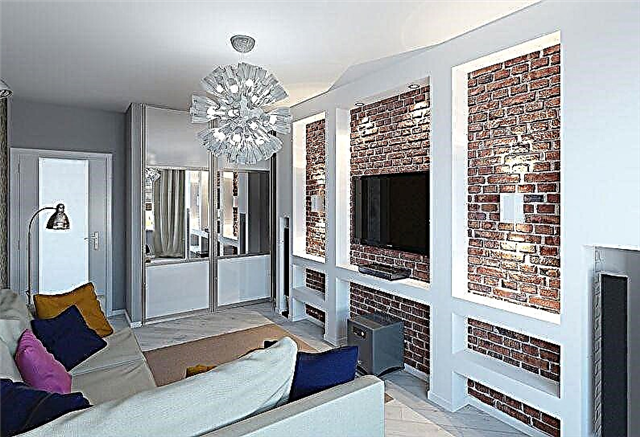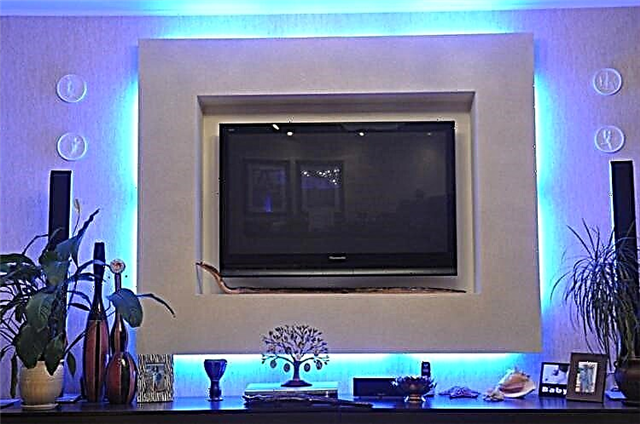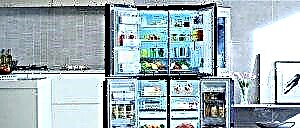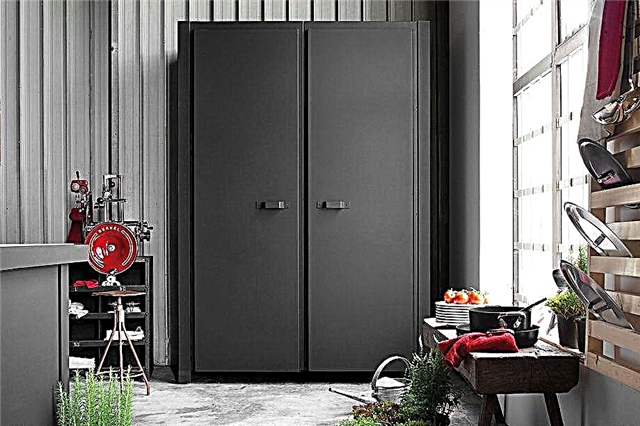
There are many options how to place the TV in the room: install it on a special cabinet, hang it on the wall with brackets or build it into a niche. The latter method is remarkable in that it allows you to hide wires and sockets, harmoniously fit the screen into the surrounding space, and often also decorate the interior in an original way. In addition, arranging a niche from drywall does not require large expenses or special skills - you only need to be able to hold a knife and a screwdriver in your hands, and we will talk about installation technology and design options in this article.
We make a niche for the TV from the GKL with our own hands
To make a beautiful portal for a TV, you need to prepare:
- aluminum profile of the brand CW (ceiling-wall) and UW (guide), for curved elements - flexible,
- accessories - connectors, suspensions, extension cords, angles,
- fasteners (self-tapping screws for gypsum plasterboard and profile, dowel),
- drywall sheets - standard, if necessary - arched,
- primer and putty for drywall,
- serpyanka tape for sealing joints, joints, internal corners,
- Decoration Materials.
Of the tools you will need a puncher (to drill holes in the wall), a level (preferably a laser), a screwdriver, a drywall knife, scissors or a hacksaw for metal, sandpaper for grinding GKL, masking thread, a spatula, a roller for finishing.
First you need to decide on the design of the future niche. It can be protruding, with open corners or in-depth. In the second option, it is necessary to close most of the wall with drywall, but thanks to this, the interior will become more thoughtful and stylish.
The shape distinguishes between rectangular horizontal, rectangular vertical, square, oval, curved and complex structures. Standard rules apply here: the lines stretched up visually raise the ceiling, and parallel to the floor allow you to expand a narrow wall. Unusual geometry is suitable for rooms with a non-standard layout or spacious rooms.

Around the TV often arrange additional shelves for stereos, decor and books. If desired, you can even make a whole rack or drywall cabinets that will look next to a niche as a single ensemble.
Installation of the construction is carried out in stages. First, using a laser level and tape measure, markings are applied to the wall, then a metal frame is constructed according to the drawing. The niche depth should be calculated based on the thickness of the TV, adding 5-7 cm to the gap for wires and ventilation. The free space between the wall and the screen is necessary for air to circulate there and cool the equipment. Around the monitor, it’s also customary to leave a place - firstly, it’s more convenient to hang and take it off, and secondly, after some time you may want to acquire a model with a larger diagonal.
Before starting work, you need to decide where the wiring will be hidden - under it you can make channels or hide it inside plastic skirting boxes.
The guide profile is mounted first, while the dowels are placed at a distance of no more than 40 cm from each other. Then, vertical elements are attached to the ceiling and floor. The base of a small niche can be done separately, and then install it on the wall.
The next step is to cover the frame with drywall, previously cut into the corresponding figures. You should start with small and complex elements. Self-tapping screws are used as fasteners, the steps between them are 25-30 cm.
When the drywall is installed, it is leveled with putty and primed. Seams and joints are reinforced with a serpentine, the outer edges are closed with perforated metal corners. A starting putty is applied on top of the primer layer, after finishing - finishing.

How to create a niche for TV
The design of a niche for a TV needs to be approached creatively - it can be partially or completely painted with water-based paint, pasted over with wallpaper, trimmed with a flexible stone, fabric, painted manually or using stencils, decorated with stucco molding from polyurethane, laid out with mosaics or decorative tiles. It is only important to adhere to a sense of style so that the portal does not conflict with the rest of the environment.
Drywall niche for TV in the living room
As a rule, the living room is not limited to just a recess under the television screen, but they arrange a whole wall - with shelves, interesting lighting, beautiful decor and paintings. This is an excellent alternative to obsolete chipboard headsets.
The drywall design takes up less space than standard cabinets and racks, and it looks more modern. In addition, having set the goal of zoning the space of an apartment, it can be installed instead of an internal partition, saving free space, materials and partially replacing furniture. Functional shelves, for example, for books, should be made of wood or durable glass - they will withstand the load and diversify the design.
Depending on the chosen style, the niche for the TV in the living room can be designed in different ways. For example, country will successfully complement a false fireplace and decorative stone, smooth asymmetry will be appropriate in modernity, minimalism requires a clear rectangular geometry, delicate floral patterns will decorate Provence, and columns, gilding and stucco molding will decorate the classics.
But with all the splendor of decoration, the central place should be occupied by television. This means that in the niche and around it you should avoid clumsy, saturated details - they will compete with the video sequence, causing eye fatigue and irritation. For the same reason, it is better to close large shelves with doors so that the variety of things on them does not cause a sense of disorder.
Benefits of Drywall Niches
Plasterboard structures have long been firmly rooted in modern interiors. They are good for zoning and rational use of space, bring personality to the chosen style, and allow you to experiment with forms.
A TV in a niche is simultaneously spectacular, neat, convenient and functional. She has several significant advantages, compared with the classic pedestals! Unlike furniture, it does not occupy space because it is built into the wall. You can make a drywall niche yourself, and this will cost less than custom-made body structures.

The TV is recessed into the drywall design, which means it will not just hang in the middle of the wall and protrude forward. Inside the box, it is easy to hide all the wires, built-in lighting and other communications. The niche is more compact than the hinged shelves, and does not take up space on the aisle.
The shape, style, size, configuration, number and location of compartments, design - you can choose all this yourself. Also, additional soundproofing is easy to sew into drywall, and a working TV will not interfere with neighbors or household in another room.

Drywall Niche for TV in the bedroom
The bedroom is an atmosphere of peace, relaxation and comfort, where there is no place for anything superfluous. And this is not a whim at all, because well-being, mood and performance directly depend on a healthy and full sleep.
Do not clutter the bedroom with unnecessary furniture and appliances - and it will always reign calm and romance. But this does not mean that you need to abandon the new series of your favorite series before going to bed.
The drywall niche in the bedroom is not only an ideal place for a TV that will not get in the way, but also a stylish atmospheric accessory. Elegant decor, delicate subdued lighting, fresh flowers or favorite photographs around - and the bedroom will be transformed.


Drywall niche for TV in the kitchen
In the first place in the kitchen is always functionality, because this is the main working room in any apartment. But the TV doesn’t hurt, because it’s more fun to do routine and enjoy spending time with your family watching your favorite films.
But when installing a TV in the kitchen, the most difficult thing is to choose a place. It is important that it does not interfere, is not too close to the stove or sink, that water and grease do not get on it, and that the protruding structure does not interfere with the passage.
Most often, the area of the kitchen is limited and not too large, so there is no question of any cabinet stands. Putting the TV directly on the work surface between the combine and the microwave oven is far from the best option, so a drywall niche comes to the rescue.


Do-it-yourself niche from drywall
Doing it yourself with a drywall niche is much easier than it might seem at first glance. This does not require special knowledge and skills - a fairly simple set of tools. But it’s better to do this after buying a TV, so that it probably fits in size without any problems.
Determine the location of the future niche, take all measurements, make a drawing and transfer the markings to the wall. For work, you will need measuring instruments, a level, a construction knife, a planer, a hand screwdriver and a drill, screwdrivers, screws and wall plugs for sheet materials.

Do not forget that the screen should not fit snugly against the structure. Leave a little space for convenient installation, connection and cleaning: on average, the shelf will be 20 cm wider than the TV.
Decide which shape fits harmoniously into your interior: strict rectangular classics, futuristic polygons, original circles and ellipses, elegant rounded corners. All this can be done from drywall!

It is important that the TV does not protrude beyond the edges of the niche, and if the outlet is supposed to be behind, an even greater supply of depth will be needed. Most reliable - moisture resistant sheets, which are more durable and resistant to changing conditions, this is especially important in a kitchen with its temperature and humidity conditions. The thickness depends on the shape and size of the niche, as well as on the expected loads.
The future design is mounted on guide profiles, so you must first install them. Fix the frame with self-tapping screws along the marking lines - and the outlines of the future niche are ready. A special knife is suitable for cutting drywall sheets, but make sure that all edges are even.

When laying drywall on the frame, make sure that all joints are smooth, without sharp recesses or protrusions. Use self-tapping screws and special butterfly dowels. Along the perimeter, all the joints and corners will have to be reinforced once again with profiles. This will give the construction additional strength, and it will look neater.
After that, you can proceed to the decoration and decoration of the niche. And then - to install a TV, brackets for which are included or sold separately.

Materials for registration
A niche in the wall can be made absolutely any shape and configuration. Among them there are some of the most common: under a furniture wall with shelves and decorative elements, under a window and a decorative fireplace installed under the TV. Depending on the style and design of the room, choose decoration materials with decorations.
Niche Painting
The simplest solution is to paint the drywall construction with regular paint. But first, carefully plaster the base to smooth out all the joints, junctions and attachment points. For a more expressive decorative effect, use textured plaster. Paint a niche in tone to the rest of the walls for simple or classic interiors, or in a bright, catchy color - for fashionable modern accents.

Wallpapering a Niche
The wallpaper option is as simple as painting, and in the same way allows you to make a niche as inconspicuous as possible. For a change, use the companion wallpapers that are in the collections of most brands. Now the combination of different textures and patterns is back in fashion, so combine a plain coating with patterns and stripes with large colors.

Stone finish
Natural stone is not suitable for facing a drywall construction - it is too heavy. But the artificial one will perfectly cope with the task, but it looks almost the same. A stone niche in a lush classic interior always looks monumental and luxurious.

Wood finish
Wooden trim is another win-win classic, because such a niche is not inferior to a full-fledged furniture set. But, as with stone, choose light woods, lightweight wood materials or imitation. It is convenient to use panels for cladding, such as lining, which are quickly mounted and hide small defects.

Niche trim
When designing a niche for a TV, boldly use everything that your soul lies to. The business involves painting, stencils, mosaics of small particles, glass or mirror inserts, stucco molding and complex polyurethane structures. You can decorate the niche with a frame, like a picture, or decorate on the sides with elegant half-columns.

Drywall niche lighting
Illumination is a stylish and convenient tool for decorating drywall constructions and niches. From the point of view of ease of installation and fire safety, spot mounted luminaires and LED strip are best proven. For creative interiors, duralight, neon tubes and threads are good.
Direct the light stream in the opposite direction from the room, otherwise it will be too bright. The most comfortable shades for vision are white and yellow, and colors can be added with blue, green or red neon. But colored or blinking ribbons are not recommended to be constantly kept on: they strain the eyes.


Advantages and disadvantages
Before deciding to create a niche from drywall for a TV, you need to consider all the pros and cons of this decision.
The following advantages of these products can be distinguished:
- ease of manufacture
- it is possible to hide wires that spoil the overall picture of the interior,
- the TV is safe: no one can accidentally hurt it or perform any action that will negatively affect its work,
- the design helps to hide the irregularities of the walls,
- savings: there will be no need to spend additional funds on TV cabinets and drawers or shelves,
- You can create designs of various shapes and sizes. It all depends on individual preferences.


Disadvantages:
- if over time a decision is made to replace the TV with a larger one, then the niche may not work, and you will have to redo it.
- in case of furniture relocation, the niche will remain in its place. In a similar situation, dismantling is required.
There are not many shortcomings. Re-erection of such a design, if necessary, does not take much time and effort. First of all, it is necessary to rely on personal preferences and opportunities.


Varieties
Niches can be completely different. The modern interior is sometimes distinguished by incredible design solutions.
It is necessary to avoid two-dimensionality, a plane when decorating rooms. Even a thin LCD TV attached to the wall will not add room to the room. Often there is a feeling of discomfort due to the unsafe arrangement of equipment. In this case, special niches are used.


Shelves are additionally made from drywall, serving as a place to store disks, books, magazines and other things. Shelves can be closed and open. The second option is more decorative.
They also make backlit elements. Recessed luminaires are installed separately on each shelf or along the entire perimeter of the structure.Thus, this serves not only as a decorative element, but also as an additional illumination, which is used as a lamp or a night lamp.


Such a portal can be decorated with a chest of drawers on which the frame stands. Also there can fit a wall for a TV.
Sometimes this design is angular, equipped with a storage area.


Shapes and sizes
There are several forms of drywall TV niches. They are oval, horizontal and vertical. Below we consider each in more detail.
- Rectangular Often this view is called horizontal. It is a fairly popular design option used in the interior. This is due to the fact that you can additionally place several shelves for storage and organization of space. Such an option is also popular because a niche of this shape is perfect for both a small room and a large one. The rectangular niche is simple to execute and does not require special knowledge and skills. It can be easily built independently.


- Vertical. Most often, this design takes place from floor to ceiling. The TV itself is installed in the center, and the rest of the space is occupied by numerous shelves and drawers. This option is not the most popular, because it can only be used in large rooms.


- Oval niche. It is an original solution. Only suitable for large rooms. The TV is located in the center of the circle, which gives the room a stylish and modern look.

No matter what shape and size a TV niche is, you should not highlight it with a dark color. It is best to use light shades. So in the room there will be no sensation of a hole in the wall. You can choose a shade two to three tones darker than the walls. So the room will look more voluminous.
Niche size may vary. It all depends on its purpose, as well as the dimensions of the TV. The main thing in size is depth. It, as a rule, should be 100 mm larger than the dimensions of the TV in each direction. This is due to the fact that so it will be easier to install, and visually it will look better.


Before proceeding with the manufacture of the product with your own hands, you must make all the necessary drawings and cut out the details, figures from the gypsum board. In the hall you can make a niche in high-tech style, and in the kitchen - in the classic.
How to issue?
The design should be approached creatively and in every possible way to think over what you want to finally see in the room. As a rule, the main opportunity that a TV niche offers is hiding wires. But there are ways to stylishly design a design that will add zest and style to the room.
- Vertical niche. Mainly used for the visual effect of a high ceiling. The rest of the space is shelves that can be placed along the entire wall. The TV in this case is in the middle.


- Horizontal niche. It is used in any room regardless of its size. Visually, this form expands the room. Especially if you combine it with low furniture.
- Plasterboard construction. It reminds an additional wall with massive shelves and a place for a TV. As a rule, shelves are open and used for decoration. For example, various statuettes, flowers, photographs and other little things are set that will simply please the eye.


- Using backlight. This method is quite original and allows you to create a romantic atmosphere in the evening. This solution can be used as additional lighting. It is worth noting that the backlight will be beneficial and beautifully emphasize objects on the shelves. It is important to understand that the light should be directed to the wall or floor, but in no case to the room. Thus, he will not blind, but will smoothly "crawl" around the room. As an unusual design solution, neon multi-colored threads can be used. So the room will be transformed at night. But if you need a more comfortable shade, choose warm white, which is considered familiar to the eye. Thanks to the yellowish undertones, a relaxed and homely atmosphere is created, which is indispensable after a hard working day, when a person wants to relax. If imitation of daylight is needed, then for this purpose a white lamp with a cold undertone is used. In this case, the colors of the objects are not distorted, but the eyes do not rest completely.




- Often build niches that are like a wardrobe. The television in this case is located behind the sliding door.
Under the TV, a decorative fireplace can also be installed that does not perform any function other than a decorative fireplace. You can also install an electric fireplace, but it is worth taking care of safety measures.


Finishing materials are often used for decoration, which are selected depending on preferences. As a rule, a niche is covered with plaster, wallpaper for walls or paint. Decorative brick, stone, glass or wood can be used.
- Wallpaper. They are the cheapest finish option. Often for the niche they use the same wallpaper with which the room is pasted. In this case, the TV completely merges with the rest of the interior and disguises itself.
- Paint. Before its application, putty is necessary. Thus, the desired texture is attached to the drywall. In this case, painting a niche performs rather a decorative function.
- A rock. As a rule, only artificial is used. It is quite easy to use and light. The main wall on which the TV is mounted is trimmed with stone. Such a solution gives even more space.


Dark details create depth and a bolder look. But it is advisable not to overdo it with similar shades. Otherwise, it can ruin the overall impression of the room. The main thing is a combination of elements among themselves. Each element in the interior should be combined with each other. Only in this case will it be possible to create a stylish room.
You should know that a niche will become an integral part of the interior. Therefore, its design should be approached seriously and creatively. It is important to understand that in the center of everything there will be a TV. That is why it is worth avoiding too bright and colorful details. Otherwise, the image on the TV screen will merge with the main wall.


If the TV niche is installed in the bedroom, then you should choose warm, delicate and bright colors for decoration. So space loading will not be felt. For a bedroom, as a rule, a small room is reserved. That is why a niche of medium or even small size should be made. In this case, a pair of shelves will be enough as additional storage space.
The symmetrical shape of the shelves of the TV niche will perfectly combine with the classic interior. This design option is ideal for the bedroom.


The asymmetric shape of the shelves is perfect for the modernist style in the interior. But this applies only to those cases when all the elements in the room are designed in the same style. This option is suitable for combined large rooms. It is most in demand in studio apartments, where there is enough free space for the implementation of bold design decisions.

It is not necessary to make additional shelves for storing things or decorating the room. It all depends on the individual preferences of the owners of the house. Thus, the design will be a kind of box in the middle of which a TV will be installed.
Below you can leave a place under a small coffee table, which will complement the overall picture.
Plasterboard niche for TV is mainly made for the living room.


Gone are the days when the TV just hung on the wall. As a rule, this option is more suitable for public places, for example, sports bars, where football matches are broadcast. Home interior involves the creation of a cozy atmosphere.
Thanks to the design of the drywall niche, a person can not only decorate the room, but also save on repair work. After all, the material is notable for its low price and good quality, which will allow you to no longer worry about the equipment.


Stylish examples in the interior
The following are good ideas for using niches from GCR in the interior.
- In the photo - a rectangular niche made of drywall with additional shelves for storage. An artificial stone was used as a decorative element.

- Niche for a plasterboard TV with one shelf. The decoration is a panel on the ceiling, which is equipped with built-in lights.

- Vertical niche with two additional shelves, which are used for TV and fireplace. This option is a stylish solution for the living room.

For information on how to make a niche for plasterboard for a TV, see the next video.
Design task: how to fit the equipment into the interior
Now there are a huge number of options for depicting concepts, however, on the one hand, they are a completely unusual design, and, on the other, a rather complicated process of creating them.

The simplest option for a drywall TV niche is considered to be a classic one made using a load-bearing wall or a drywall surface that serves as the back wall.

There are so-called portal elements, which are a niche from the ceiling to the floor. The relevance of using this kind of structural elements lies in the implementation of numerous ideas, even in those cases when there is no even cladding. The final result looks quite harmonious and dignified.

Such a portal is mainly framed by two fairly wide columns. The variant of the form is selected taking into account the wishes of the customer, while in no way, without affecting its functional use.

The most complex forms include curved versions of the front or side. Such a construction may well be supplemented by additional shelf options used to house a home theater and other equipment.

More options can be seen in the photo of a niche for a TV.

Watch the video: How to make a niche for plasterboard TV
A very original living room with panoramic windows - firstly, huge windows let in a lot of light and air into the room, secondly, dark shades of wood in everything, but they don’t look heavy due to such a luxurious window. In our apartments, more often - the windows are smaller by an order of magnitude, so you should pay attention to the lighter interiors - or balance this with a lot of light with the help of chandeliers, lamps - table, floor.
TV mount and load
Recently, the technology has become much more compact compared to previous versions, but despite this, it occupies a quite significant place. Its dimensions must be mentioned when creating the main frame of the niche for a more reliable fastening.

Basically, TVs are installed using hanging mounts at the level of a meter from the floor covering. This gives the element of furniture a certain lightness and calmness.

The fastening of the TV panel to the wall of drywall is accompanied by certain requirements:
- reinforcement of the rear part - is selected taking into account the weight category of the installed equipment,
- bracket mounting is carried out strictly according to the instructions - for reliability it is better to use four mounting points,

As fasteners, it is better to use metal dowels in the form of an umbrella and the Hartmouth mount. If there is a wall of brick or concrete, it is recommended to use bolted or chemical options for anchors.



Direct assembly of the main frame
When compared with other furniture options, the TV niche has a separate assembly structure. The only similarity is that it has a main element and additional details of a special figure that have a shaping function.

For non-standard options for forms, a special so-called bent profile is best suited, which can create a suitable bend of the desired shape.

The assembly process itself is as follows:
1. Installation of guide profiles. The most advantageous option for optimum load is 50 mm.

2. Approximately 4 rows of guides are nailed to the draft version of the plane, and in the case of continuous sheathing, to hidden drywall profiles.

3. At the foot is mounted an ordinary podium of small size.



4. If there are side columns, it is recommended to duplicate the guides, between which it is necessary to insert special jumpers of the required length, they will carry out the depth of the recess.

There are several options for connecting a profile:
- with bent wings ",
- the use of "crab",
- using a special insert serving as a possible profile extension,
- the best option is the notch.

One more point should be taken into account: it is recommended to lay all having wires in the inner plane of the structure before sewing the frame.

The final stage: lining and decoration
The process is not a special technology. For a curved version, drywall must be soaked.

As for the corner parts and joints, the requirements in this case are quite strict. To finish the interior, you need a paint that has an antistatic effect. Horizontal shelves are best covered with a thin version of the glass of the required size.





